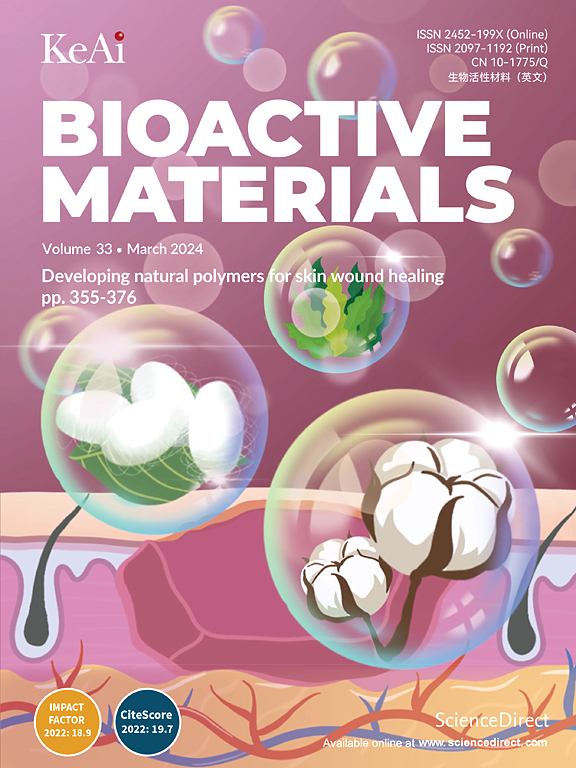A micro-metabolic rewiring assay for assessing hypoxia-associated cancer metabolic heterogeneity
IF 18
1区 医学
Q1 ENGINEERING, BIOMEDICAL
引用次数: 0
Abstract
Cancer metabolism plays an essential role in therapeutic resistance, where significant inter- and intra-tumoral heterogeneity exists. Hypoxia is a prominent driver of metabolic rewiring behaviors and drug responses. Recapitulating the hypoxic landscape in the tumor microenvironment thus offers unique insights into heterogeneity in metabolic rewiring and therapeutic responses, to inform better treatment strategies. There remains a lack of scalable tools that can readily interface with imaging platforms and resolve the heterogeneous behaviors in hypoxia-associated metabolic rewiring. Here we present a micro-metabolic rewiring (μMeRe) assay that provides the scalability and resolution needed to characterize the metabolic rewiring behaviors of different cancer cells in the context of hypoxic solid tumors. Our assay generates hypoxia through cellular metabolism without external gas controls, enabling the characterization of cell-specific intrinsic ability to drive hypoxia and undergo metabolic rewiring. We further developed quantitative metrics that measure the metabolic plasticity through phenotypes and gene expression. As a proof-of-concept, we evaluated the efficacy of a metabolism-targeting strategy in mitigating hypoxia- and metabolic rewiring-induced chemotherapeutic resistance. Our study and the scalable platform thus lay the foundation for designing more effective cancer treatments tailored toward specific metabolic rewiring behaviors.

用于评估缺氧相关癌症代谢异质性的微代谢重组试验
肿瘤代谢在治疗耐药中起着至关重要的作用,肿瘤间和肿瘤内存在显著的异质性。缺氧是代谢重新布线行为和药物反应的重要驱动因素。因此,概述肿瘤微环境中的缺氧景观为代谢重布线和治疗反应的异质性提供了独特的见解,从而为更好的治疗策略提供信息。目前仍然缺乏可扩展的工具,可以方便地与成像平台接口,并解决缺氧相关代谢重新布线中的异质行为。在这里,我们提出了一种微代谢重布线(μMeRe)测定,提供了表征缺氧实体瘤背景下不同癌细胞代谢重布线行为所需的可扩展性和分辨率。我们的实验通过细胞代谢产生缺氧,无需外部气体控制,从而表征细胞特异性的内在能力,以驱动缺氧并进行代谢重新布线。我们进一步开发了通过表型和基因表达来测量代谢可塑性的定量指标。作为概念验证,我们评估了代谢靶向策略在减轻缺氧和代谢重联诱导的化疗耐药中的功效。因此,我们的研究和可扩展的平台为设计针对特定代谢重新布线行为的更有效的癌症治疗奠定了基础。
本文章由计算机程序翻译,如有差异,请以英文原文为准。
求助全文
约1分钟内获得全文
求助全文
来源期刊

Bioactive Materials
Biochemistry, Genetics and Molecular Biology-Biotechnology
CiteScore
28.00
自引率
6.30%
发文量
436
审稿时长
20 days
期刊介绍:
Bioactive Materials is a peer-reviewed research publication that focuses on advancements in bioactive materials. The journal accepts research papers, reviews, and rapid communications in the field of next-generation biomaterials that interact with cells, tissues, and organs in various living organisms.
The primary goal of Bioactive Materials is to promote the science and engineering of biomaterials that exhibit adaptiveness to the biological environment. These materials are specifically designed to stimulate or direct appropriate cell and tissue responses or regulate interactions with microorganisms.
The journal covers a wide range of bioactive materials, including those that are engineered or designed in terms of their physical form (e.g. particulate, fiber), topology (e.g. porosity, surface roughness), or dimensions (ranging from macro to nano-scales). Contributions are sought from the following categories of bioactive materials:
Bioactive metals and alloys
Bioactive inorganics: ceramics, glasses, and carbon-based materials
Bioactive polymers and gels
Bioactive materials derived from natural sources
Bioactive composites
These materials find applications in human and veterinary medicine, such as implants, tissue engineering scaffolds, cell/drug/gene carriers, as well as imaging and sensing devices.
 求助内容:
求助内容: 应助结果提醒方式:
应助结果提醒方式:


